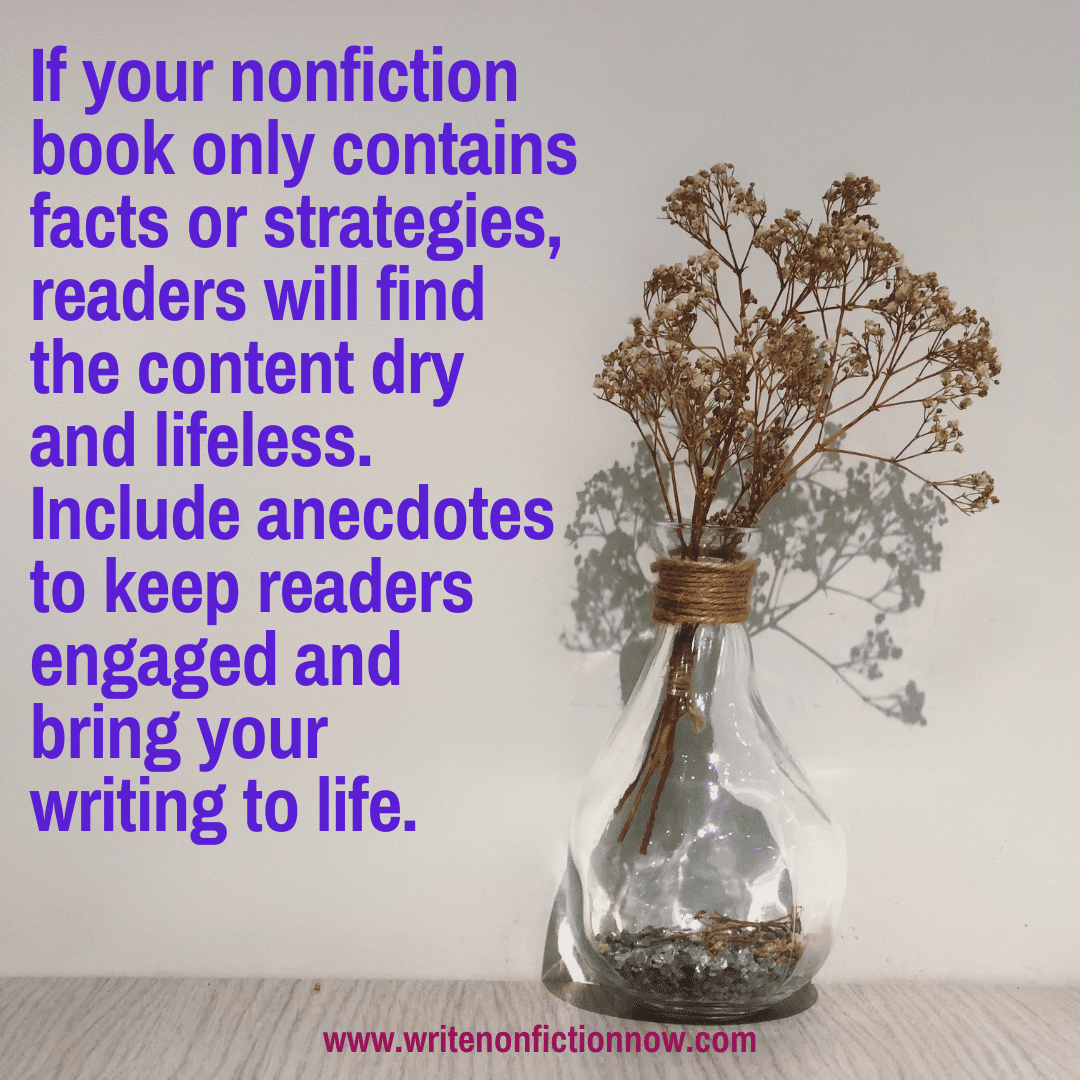Wednesday, April 6, 2022

Nonfiction books provide data and facts, but that doesn’t mean they have to be dry. In fact, if all you do is stick to the facts, you may lose your readers. But a healthy smattering of anecdotes turns your nonfiction into compelling prose that connect with your readers. Today,
Jay Artale (
@BirdsOAFpress) explains why you need to include anecdotes in your nonfiction book and how to do so.
When writing your nonfiction book, a key ingredient is the inclusion of anecdotes. Without this concise storytelling, your book could read like a textbook. However, as soon as you add anecdotes to your manuscript, you strengthen your ability to connect with your audience.
The Power of Stories
To understand the appeal stories have, just look at the billions of dollars generated by the global box office each year. Or consider the revenue amassed by streaming services like Netflix, Apple, and Amazon Prime (to name a few). Whether they’re fictional or documental, we’re drawn to movies and television series like a moth to a flame because they tell stories.
Stories help us connect and foster empathy. This critical element of human nature has the power to stop us in our tracks and help us connect to others at a deeper level. We don’t even have to know the people personally to create that connection.
Anecdotes vs. Data
As nonfiction authors, we can learn from the traditional news media. They don’t just report the facts and figures; instead, they humanize the topics with personal stories that help us relate.
For example, during the Covid-19 pandemic, governments have provided data about the death toll. However, the news outlets don’t simply report those numbers; they go in search of people who are willing to share their stories of loss and how the pandemic impacted them.
Which has more impact on you?
- There have been nearly seven million Covid deaths
- An elderly mother died alone in her hospital bed. Strict visitation rules didn’t allow her family to visit. Nurses were so busy tending to other patients that nobody held this mother’s hand as she slipped away.
The first summary of facts connects with us on an analytical level. The second one touches us emotionally and tugs at our heartstrings.
When information is personalized, it’s easier to step into another person’s shoes. This helps people struggling with a similar scenario experience an instant connection or bond.
No matter how much data or facts you add to your nonfiction book, your expertise could still fail to connect with an audience. But convert that knowledge into a first or second-hand account story, and your audience will be drawn in on an emotional level. This is what’s going to get them to care about your book.
Data and facts are critical when writing nonfiction. But no matter how accurate or compelling they are, your book won’t attract broad audience appeal unless you personalize it with stories.
Use Anecdotes Sparingly
If you’re writing a memoir, most of your book relies on long-form, first-hand accounts. However, if you’re writing a nonfiction book on a specific topic based on facts, you’ll need to find a balance between data and personal stories. To work effectively, your anecdotes need to support the overall context and not cause a distraction from the book.
Anecdotes Show Instead of Tell
Nobody enjoys being lectured at, so, rather than telling your readers what they need to do, show them. For instance, you can use an anecdote as a positive reinforcer to illustrate the favorable impact of a new course of action. Or, you can also use an anecdote as a cautionary tale to show the adverse effects of inaction. When you illustrate a concept with an anecdote, your readers get the point without feeling that you are preaching.
Anecdotes make your point more effectively than a narrative summary of the benefits or pitfalls. These concise stories also provide an effective way to simplify complex issues.
No matter how short your anecdote, it still needs to have a structure. The story should let your readers know who is involved and what happened. If it applies to the point you’re trying to make, you can include the when and where details, too. The key to writing an effective anecdote comes in limiting it to relevant information that gets your point across. Your first attempt at writing an anecdote may result in a full-blown story. Still, a few rounds of editing will help you trim the fat and keep your anecdote from meandering.
Source and Style of Anecdotes
Take some time to research how other writers use anecdotes. Review nonfiction books within your niche and see how the authors used anecdotes to support the chapter topics. This will familiarize you with how other authors’ work relies on stories. And you will see how they’ve incorporated them into the rest of the text.
As you do this research, here are some things to look for:
- Have authors interviewed experts or thought-leaders in their field or talked to people who have successfully tried the book’s techniques?
- Have they incorporated the anecdote as dialogue or shared it in a narrative format?
- Does the book include a few case studies that thread through the chapters, or has the author used stand-alone anecdotal examples for each scenario?
Anecdotes Punctuate Your Writing
I like to think of anecdotes as an elaborate form of punctuation. A well-written anecdote helps readers consume your content without distracting them. During the early writing stages, I capture my books’ core concepts and ideas. Then, during the editing stages, I identify where my text could benefit from the addition of a well-placed anecdote.
Anecdotes provide a powerful tool to strengthen your book’s impact on its readers. These concise stories showcase personal experiences that create empathy and balance the factual nature of nonfiction.
If you’ve added anecdotes to your nonfiction book, how easy was it for you to incorporate them into your manuscript? Share your experience to help other authors connect with their audience.
About the Author
Jay Art ale abandoned her corporate career to become a digital nomad and full-time writer. She’s an avid blogger and a nonfiction author helping travel writers and travel bloggers achieve their self-publishing goals. Join her at Birds of a Feather Press where she shares tips, advice, and inspiration to writers with an independent spirit.
ale abandoned her corporate career to become a digital nomad and full-time writer. She’s an avid blogger and a nonfiction author helping travel writers and travel bloggers achieve their self-publishing goals. Join her at Birds of a Feather Press where she shares tips, advice, and inspiration to writers with an independent spirit.
 Do you want to learn more about becoming a successful nonfiction author? Check out the Nonfiction Writers’ University. Get the education and coaching to help you succeed as a nonfiction writer. Take advantage of monthly live group author coaching, and gain access to an extensive archive of educational resources, like interviews with experts, challenges, homework assignments, courses, and ebooks. If you’ve wanted one place to go for all your nonfiction writing and publishing needs, this is it. And if you’ve wished you could purchase Nina Amir’s best courses or hire her as your author coach, now you can…for a small monthly investment. Enjoy a 30-day trial membership for only $1.
Do you want to learn more about becoming a successful nonfiction author? Check out the Nonfiction Writers’ University. Get the education and coaching to help you succeed as a nonfiction writer. Take advantage of monthly live group author coaching, and gain access to an extensive archive of educational resources, like interviews with experts, challenges, homework assignments, courses, and ebooks. If you’ve wanted one place to go for all your nonfiction writing and publishing needs, this is it. And if you’ve wished you could purchase Nina Amir’s best courses or hire her as your author coach, now you can…for a small monthly investment. Enjoy a 30-day trial membership for only $1.
Photo courtesy of mukphotos.
Nina Amir, the bestselling author of How to Blog a Book and The Author Training Manual, is a speaker, a blogger, and an author, book, blog-to-book, and high-performance coach. Known as the Inspiration to Creation Coach, she helps creative people combine their passion and purpose so they move from idea to inspired action and positively and meaningfully impact the world as writers, bloggers, authorpreneurs, and blogpreneurs. Some of Nina’s clients have sold 300,000+ copies of their books, landed deals with major publishing houses and created thriving businesses around their books. She is the founder of National Nonfiction Writing Month, National Book Blogging Month, and the Nonfiction Writers’ University. As a hybrid author she has published 19 books and had as many as four books on the Amazon Top 100 list at the same time. Her most recent book is called Creative Visualization for Writers, and tomorrow her 19th book will be released, The Write Nonfiction NOW! Guide to Creativity and Flow. Find all her books at booksbyninaamir.com or find out more about her at ninaamir.com.